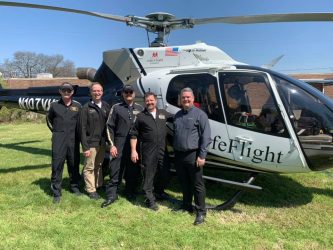Vanderbilt LifeFlight visits Rotary
Posted By Josh Nelson

Our club was fortunate to hear from Kevin Noonan last Thursday, who is the Director of Vanderbilt LifeFlight.
“We’re often referred to as the flying billboard for Vanderbilt,” he said. “Most of the time when we say, ‘What is LifeFlight?’ what people think about are the helicopters…which is who we are and what we do, but we’re a lot more than that – we’re not just an air transport service; we also provide ground services and a lot of the communication (when someone is severely injured).”
Noonan said they have experienced phenomenal growth during their existence.
“We started on July 5 of 1984…and over the last 35 years, we’ve transported about 45,000 missions,” he said. “Back when we started 35 years ago, we had a single aircraft, and we based it at Vanderbilt. We now have eight helicopter bases and many other divisions within LifeFlight.”
Those bases are located in Lebanon, Tullahoma, Clarksville, Mt. Pleasant, Murfreesboro, Paris, Cookeville, and Humboldt.
“We cover – pretty much – the etire state,” Noonan said. “We also cover portions of Kentucky and Northern Alabama. That’s just with our helicopters.”
They fly three different kinds of choppers. One works like one would imagine, like an ambulance in flight with the patient treated in the back, but there is also one where the patient is treated right next to the pilot.
“One of the common misperceptions people have is that we always fly our people to Vanderbilt,” Noonan said. “That’s just not the case; we’ll fly our patients to wherever is appropriate – when we look at our stats from Humbloldt, less than 50 percent come back to Nashville; we’re transporting them to Memphis or to the hospital there in Jackson.
No matter where the patient is headed, they are given the best care in a tiny space.
“Think of us doing critical care in essentially the size of a bathtub,” Noonan said. “We’re much like an ICU (intensive care unit); we can put you to sleep, we can put down a breathing tube, we can make an incision in your neck and ventilate you through there if we have to. If you have a collapsed lung, we can put in a tube to inflate your lungs…we have a lot of capabilities – most of the equipment you would find in the ICU, we have most of that equipment in the back of the aircraft.”
As for Gallatin, specifically, Noonan said, “We can be here in about 14 minutes and we have about a 15-minute flight back to Vanderbilt, which is not very long at all.”
Noonan then told the club about calls to Sumner County.
“About 74 percent of the calls out of Sumner County are intra-facility, meaning they come out of a hospital,” he said. “The other 26 percent are scene flights.”
Noonan said of the scene flights in 2018 to Sumner County, 37 percent were trauma, 11 percent were cardiac or heart attacks…and 37 percent was strokes and neuroligical illnesses.
Noonan said they will continue to add to their services to the Middle Tennesse region.
“In the coming months, we’re going to start a critical care ground service,” he said. “When our aircraft can’t fly(due to weather), we will still be able to come with ambulance and provide essentially the same level of care does except it will be by ground.”
This is just a portion of what Mr. Noonan said to the club; to hear his full presentation, click on the link below.